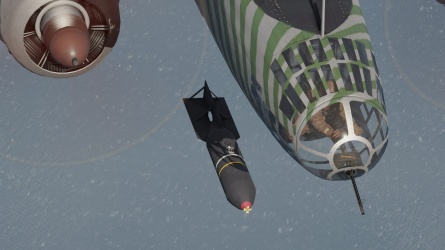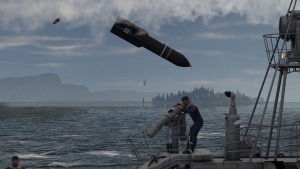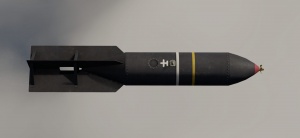Army Type 92 GPHE (500 kg)
| This page is about the Japanese bomb Army Type 92 GPHE (500 kg). For other uses, see Type 92 (Disambiguation). |

Contents
Description
Army Type 92 GPHE (500 kg) was a bomb used by the aviation of the Imperial Japanese Army during the World War Two, primarily on its frontline bombers. It's a very competent explosive, able to deal with tanks and naval vessels alike.
Vehicles equipped with this weapon
General info
| Bomb characteristics | |
|---|---|
| Mass | 500 kg |
| Explosive mass | 223 kg |
| Explosive type | Shimose |
| TNT equivalent | 245.3 kg |
| HE max penetration | 92 mm |
| Armour destruction radius | 10 m |
| Fragment dispersion radius | 139 m |
Effective damage
The bomb produces high explosive damage, able to overpressure soft-body vehicles from even a relatively distant explosion. Dealing with harder targets, such as tanks, or fully armoured tank destroyers, requires the bomb to land within less than 10 meters from the target. Against blue water naval vessels, either a direct hit is required, or dropping the bomb ahead of the vessel, so that it'd explode under the keel while sinking to maximise the damage output.
Comparison with analogues
Type 92 can be considered an iconic 500 kg bomb, featuring a spot-on 500 kg mass and average explosive filler. Compared to its naval equivalent, it boasts a slightly larger explosive filler, but the difference is unlikely to be palatable in a real combat.
| Bomb | Mass (kg) |
TNT equivalent (kg) | |
|---|---|---|---|
| |
1,000 lb AN-M65A1 | 501 | 318.48 |
| |
1,000 lb LDGP Mk 83 | 447 | 272.43 |
| |
SC500K (500 kg) | 500 | 260 |
| |
FAB-500sv (500 kg) | 508.3 | 325 |
| |
FAB-500M-43 (500 kg) | 468.57 | 243.71 |
| |
FAB-500M-44 (500 kg) | 477.1 | 222.15 |
| |
M.C. 1,000 lb Mk.I | 463 | 215.4 |
| |
500 kg Type 92 GPHE | 500 | 245.3 |
| |
Navy Type Number 50 Model 2 | 500 | 227.5 |
| |
GP 500 (500 kg) | 508 | 216 |
| |
500 kg No.2 | 520 | 255.68 |
| |
400 kg Vliegtuigbom | 400 | 167 |
Usage in battles
Typically, for a 500 kg bombs, it features a nice compromise between the mass of the bomb and its destructive capability. It's able to knock out tanks from near-misses and heavily cripple, if not outright destroy, frigates and destroyers.
Pros and cons
Pros:
- Good TNT equivalent of the explosive filler
Cons:
- Available only on bombers. No option to use it on strike craft or fighters.
History
Type 92 High-Explosive bomb was used by the Imperial Japanese Army during the World War Two. It had a black steel body with a cast red-tipped nose cone. The body had two bands: one yellow and one white, ahead of the suspension lug. Filling was made of pre-formed paper-wrapped Picric acid blocks, consisting a total of 46.4% of the body mass of the bomb. It used a nose-mounted fuse, either Type 92 Tail Fuse For Large Bombs B-4 (a), which fused instantly on impact or Type 92 Nose Fuse For Large Bombs A-4 (a), which used almost instantly as well, but had a more complex design.
These bombs were used primarily against ground targets - IJA used Type 4 bombs against naval surface vessels.
Media
Excellent additions to the article would be video guides, screenshots from the game, and photos.
See also
External links
- [WW2 Data Blog] Imperial Japanese Army Explosives - Bombs (Part 1)
- [Bulletpicker] TM 9-1985-4/TO 39B-1A-11 JAPANESE EXPLOSIVE ORDNANCE, page 9





